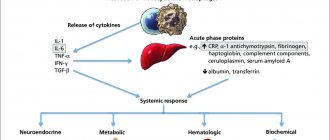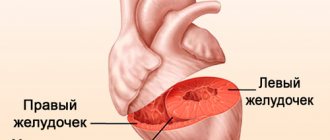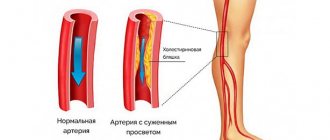Cortisol – stress hormone
Cortisol is a steroid hormone that helps a person respond to expression. It is called the “stress hormone” because it is involved in the development of stress reactions in the body. Steroid hormones are a category of biologically active substances that are produced in the adrenal glands.
Cortisol is beneficial to a person in the short term, but during long-term stress, excessive cortisol production leads to a condition known medically as adrenal fatigue. Increased levels of stress, and therefore cortisol, make a person feel worn out and exhausted, which leads to depression.
Cortisol (the norm in women rarely changes by age), its level reaches its peak in the morning, around 8 o’clock, which helps a person feel healthy and active in the morning. The lowest peak production is around 3-4 am.
How does cortisol affect the human body?
The hypothalamus and pituitary gland, located in the brain, regulate cortisol levels. If there is a decrease, the brain “orders” the adrenal glands to increase the production of the hormone, and they begin to increase the amount of cortisol released. Cortisol levels are the main indicator of the functional activity of the adrenal glands.
Since most cells have their own cortisol receptors, it affects many body functions:
- the hormone is involved in metabolism;
- controls sugar levels;
- helps the body convert fats, proteins, carbohydrates into useful energy;
- affects salt and water balance, thus controlling blood pressure;
- plays a major role in the body's response to stress;
- has anti-inflammatory and antiallergic effects; at the cellular level suppresses the production and action of inflammatory cytokines;
- During pregnancy, cortisol supports the developing fetus.
Many doctors argue that cortisol's main function is to help the body cope with perceived threats. But there is a downside to cortisol production.
In case of its excess, if stress is not followed by physical activity or relaxation, disorders are possible:
- the development of diabetes, since unspent glucose formed at the time of increased hormone production leads to the development of steroid diabetes mellitus;
- obesity, since excess glucocorticoids cause an increase in appetite, a person involuntarily begins to intensively eat flour and sweets (this condition often occurs after experiencing stress);
- a decrease in the number of leukocytes, which, on the one hand, blocks allergic reactions, and on the other, promotes slow healing of wounds;
- inhibits the regulation of protein biosynthesis in tissues, breaking it down into amino acids, while suppressing collagen synthesis in women, which leads to loose, thin skin, and the appearance of wrinkles;
- increased production of gastric juice, which leads to the appearance of stomach ulcers (constant stress contributes to this).
Signs
Normal production of cortisol in the body regulates glucose levels, promotes the destruction of fat deposits and protein metabolism, inhibits inflammatory processes, and stimulates healthy reactivity and excitability of the nervous system.
Slightly elevated cortisol levels can be observed in healthy men for a number of reasons: constant overload, injury, viral infections and inflammation. This occurs when cortisol is produced as a result of the body's healthy response to a stressful situation, but after the protective function is performed, the level of this hormone does not decrease.
Signs that cortisol may be elevated in men:
- Constant craving for sweet and fatty foods;
- Rapid weight gain due to fat deposits;
- Depression and fatigue, insomnia;
- Weakened immunity and frequent colds;
- Digestive disorders - heartburn, belching, constipation, diarrhea;
- Muscle pain.
These signs primarily signal that the body is subjected to excessive stress; this can be a consequence not only of physical labor, but also of training and/or diet. A state of overexertion can also occur as a result of abuse of alcohol, energy drinks and sedatives. In this case, it will be enough to give up destructive overloads, stop taking antidepressants and take a strengthening course of vitamins and minerals specially designed for men. It is especially useful to include foods high in vitamin C in your diet, which have an antioxidant effect. In some cases, it is worth trying to relieve overexcitement with a two-week course of taking tincture of valerian root.
Long-term persistence of signs of elevated cortisol can lead to chronic diseases.
Norms of hormone levels in the blood of women by age
Women's and men's reactions to stress differ. Recovery from experiences in men occurs much faster, and glucocorticoid levels decrease over a shorter period. After stress, women take longer to return to normal; their hormonal levels decrease gradually, which affects their health.
The concentration of cortisol occurs even more strongly with age and in working women with children.
Cortisol (the norm for women by age is not much different from that for men) is produced per day in the range of 15-30 mg. The morning norm, when peak production occurs, is 101-536 nmol/l, and the evening dose of the hormone is 80-478 nmol/l. During pregnancy, women experience a 2-5 fold increase in levels in the 3rd trimester.
Cortisol is a hormone necessary for the body. The norm for women changes with age, and there are other factors.
Studies have shown that working women's cortisol levels increase greatly in the evenings, when they also have to do housework. In men, the reduced level of the hormone persists in the evening.
Cortisol levels in women by age:
| Age groups | Normal blood level nmol/l | Free cortisol in urine |
| Teenagers from 12 to 15 years old | 75 – 630 | 55–270 nmol/day |
| Adults from 16 to 45 years old | 101 — 535 | 30 – 270 nmol/day |
| After 45 years | less than 130 | 35–300 nmol/day |
| Pregnant | Exceeds the value from 2 to 5 times the norm | |
A sharp increase in the hormone does not have a critical effect on health. 1-2 hours after experiencing shock, the hormone half-disintegrates, its excess is inactivated by the liver and excreted in the urine.
A surge in hormone levels often occurs during injuries, infections, operations, or when glucose levels decrease. A persistently high level within 552 nmol/l indicates the development of Cushing's syndrome. At higher concentrations, adrenal cancer is often diagnosed.
Causes and methods of normalizing hypocortisolism in men
If cortisol in men is low, this deviation is called hypocortisolism. The causes of this disturbance in the production of a hormonal element may be:
- adrenal tumors;
- malfunction of the hypothalamic-pituitary system;
- hypofunction of the thyroid gland;
- carrying out radiation therapy;
- surgery to remove the adrenal glands.
In addition, a sharp refusal to take hormonal medications can contribute to the fact that cortisol is low in men. Stopping the supply of glucocorticoids from the outside temporarily “knocks” the body out of its usual rhythm, so cortisol levels can decrease significantly.
Hypocortisolism can manifest itself:
- sudden weight loss;
- hypotension;
- attacks of dizziness;
- nausea;
- headaches;
- general weakness;
- loss of appetite;
- stomach upsets;
- mood changes;
- decrease in blood glucose concentration.
The symptoms of hypocortisolism are similar to the symptoms of a lack of other hormones in the body. For this reason, understanding the causes of the malaise on your own is extremely problematic. This should be done by a doctor, based on the results of diagnostic studies.
How to recognize changes in a woman’s cortisol levels without tests?
External signs indicating a changed level of the hormone in the blood:
- osteoporosis;
- increased blood pressure;
- thinning of the skin, the appearance of stretch marks on its surface;
- weight loss or weight gain for no obvious reason, which is accompanied by lethargy and muscle weakness.
High cortisol levels indicate Cushing's syndrome, symptoms of which include:
- abdominal obesity;
- moon-shaped round face;
- dorsal hump;
- increase in fat deposits on the back of the neck;
- thin and fragile skin, with poorly healing wounds;
- stretch marks (red stretch marks) on the stomach, chest, neck, hips.
- disruption or cessation of the menstrual cycle;
- infertility;
- increased facial hair growth;
- frequently recurring thrush.
Increased hormone levels
Against the background of a consistently high hormone level, the following changes occur:
- Muscle mass decreases. The body begins to synthesize energy from muscle tissue, and not from carbohydrates and fats supplied with food.
- Fat mass increases. Sugar can temporarily reduce cortisol. A person constantly craves sweets, which provokes overeating and weight gain.
- The belly is growing. Elevated cortisol causes the accumulation of belly fat. These fats push forward the muscles under which they are deposited, forming a belly that gives the silhouette an apple shape.
- Type 2 diabetes mellitus develops. Cortisol reduces insulin production and triggers the release of glucose due to the breakdown of muscle tissue. The result of these processes is a double increase in blood sugar.
- Testosterone levels decrease. The higher cortisol, the lower testosterone drops.
- The body's protective functions deteriorate. Cortisol exhibits an anti-inflammatory effect, the prolonged exposure of which begins to suppress the immune system.
- The risks of cardiovascular pathologies increase. Against the background of high cortisol, the body works to the limit, which can cause a heart attack or stroke.
- Osteoporosis develops. An increased concentration of cortisol impairs the absorption of calcium and collagen, slows down regenerative functions, and increases bone fragility.
Cortisol plays a big role in the body; it produces energy, which is used to perform tasks of varying complexity. The hormone is also used in psychotherapy in the treatment of patients with phobias. Prolonged elevated concentrations of cortisol in the blood lead to the following negative consequences:
- Memory impairment;
- Constant fatigue;
- Destruction of the body (thyroid dysfunction, blood pressure surges, weakened immunity).
When pathological symptoms appear, it is recommended to rest more and try to get positive emotions. At the end of the working day, it is recommended to communicate with friends, quiet activities, and listen to music. It is recommended to get a good night's sleep as cortisol balance returns to normal at night.
Laboratory diagnostics
A cortisol test is more often done using a blood test. Samples are taken twice a day, morning and afternoon. Because cortisol levels fluctuate throughout the day, your doctor will need to determine whether levels of the hormone fluctuate at an appropriate rate.
Saliva testing has become popular recently and involves measuring cortisol levels 4 times a day.
A form of urine testing is used, where urine is collected over a 24-hour period. When diagnosing the functional functioning of the adrenal glands, the level of free cortisol is determined; for this, 100-130 ml of the daily volume of urine is taken.
It is important that the doctor knows what medications were used before taking the test, since many of them lead to inaccurate results. Serum cortisol is determined using an automated chemiluminescent immunoassay. The results of blood sampling are provided on the second day.
Preparing for analysis
Before blood collection, you should fast for 8 to 12 hours. During the day, you need to give up physical activity, refrain from emotional experiences, cigarettes, alcohol, and salty foods. Before taking the analysis, 30-40 minutes. should be done in complete rest.
Blood collection
When studying cortisol levels, the analysis is taken no later than 10 am.
Venous blood sampling should not be carried out after radiography or physiotherapeutic procedures.
Analysis deadline, interpretation of results
For samples taken before noon, results should be: 171–536 nmol/L. Taken after 17 hours: 64–327 nmol/l. Time to receive test results: 1–2 calendar days, for urgent execution: 3–5 hours.
Decrease in cortisol relative to normal
Disturbances in the functioning of the endocrine system lead to cortisol deficiency.
Symptoms of its manifestation:
- decrease in blood pressure;
- reduced emotional background;
- gastrointestinal upset, nausea, vomiting;
- disruption of the menstrual cycle or its absence.
Causes
In Addison's disease or chronic adrenal insufficiency, cortisol levels are always low.
Symptoms accompanying the disease:
- constant fatigue;
- sudden loss of weight and appetite;
- skin pigmentation;
- hypoglycemia;
- low blood pressure;
- craving for salty foods.
The most common causes of decreased hormone levels are:
- congenital adrenal hyperplasia;
- hypothyroidism;
- tumor in the brain area;
- taking barbiturates;
- taking hormone antagonist drugs (ephedrine, dexamethasone, ephedrine);
- abrupt withdrawal after prolonged use of glucocorticoids;
- cirrhosis, hepatitis.
Clinical manifestations
When the level of the hormone decreases, muscle pain often develops after exercise, and microtears in the muscles. Weight loss may occur, which is often accompanied by fainting and headaches.
Some symptoms are not always associated with diseases:
- decreased appetite;
- decreased blood pressure;
- fatigue;
- mood swings;
- low blood sugar levels.
Symptoms
Symptoms of elevated cortisol:
- Prolonged stress without adequate reasons;
- Sensitivity to pain;
- Severe insomnia that disturbs the normal rhythm of life;
- Uncontrolled appetite;
- Feeling of weakness and fatigue when not exercising;
- Constant muscle pain, trembling;
- Decreased sexual desire;
- Skin pigmentation,
If these symptoms occur, you should immediately consult a doctor, since without proper treatment there is a risk of irreversible damage to the endocrine system, muscular dystrophy, mental illness, and other serious complications.
Increased cortisol levels
Cortisol (the norm in women by age, due to health reasons, can increase in the autumn), its high level is dangerous due to excessive weight gain, fluctuations in blood pressure, the occurrence of osteoporosis, disruption of the digestive process, and increased cholesterol levels.
An increase in hormone production may be a sign of developing neoplasms, pituitary tumors, anorexia, and diabetes.
Causes
Among the causes in the first place are internal disorders and diseases:
- lung and stomach cancer;
- cirrhosis of the liver;
- hypothyroidism and hyperthyroidism;
- development of male secondary sexual characteristics in women;
- uncompensated diabetes mellitus;
- hyperfunction of the adrenal cortex;
- hypoglycemia;
- obesity and depression.
External reasons:
- chronic stress, which provokes the body to produce more energy;
- diets, especially protein diets, fasting, which entails a decrease in glucose levels;
- excessive consumption of caffeine-containing products, which can increase cortisol levels by 35%;
- chronic lack of sleep;
- taking medications that include atropine, cortisone, estrogens;
- taking oral contraceptives;
- pregnancy;
- intense physical activity.
Signs
The very first warning symptoms of elevated cortisol are changes in taste sensations. Increased production of the hormone affects the heart rate, increasing it.
Subsequently, other signs may appear:
- constant feeling of hunger;
- menstrual irregularities;
- evening swelling in the arms and legs;
- frequent appearance of blush on the cheeks;
- rashes, pigmentation on the skin;
- excess hair growth on the face and body;
- numerous stretch marks on the skin;
- muscle weakness;
- constant feeling of drowsiness;
- decreased immunity, expressed in frequent colds;
- irritation, apathy, depression.
Brief mechanisms of hormone formation and function
Synthesis
Being the main glucocorticosteroid of the zona fasciculata of the adrenal cortex, cortisol is synthesized through a series of intermediate transformations from cholesterol supplied with food. Its production and secretion into the blood by the adrenal glands depend on daylight hours, diet, physical or psychological stress, pain, fear, anxiety and many other factors.
| stress, circadian rhythm → hypothalamus (CRH) → pituitary gland (ACTH) ↓ (negative feedback) adrenal cortex (cortisol) → target tissue receptors |
Regulation is carried out by adrenocorticotropic hormone of the pituitary gland (ACTH). ACTH secretion occurs (mainly) under the influence of:
- Corticotropin-releasing hormone (CRH), or corticoliberin. It is released into the blood of the vascular portal system, which connects the hypothalamus with the pituitary gland, in accordance with the circadian (daily) biorhythm. This ensures that cortisol levels begin to increase after a person falls asleep. It reaches its maximum concentration at 7-9 hours, minimum at 22 hours, after which it begins to increase again. This biorhythm depends on the length of daylight hours and the cyclical nature of nutrition.
- Cortisol itself is based on the principle of “negative feedback” with the hypothalamus (long chain) and the pituitary gland (short chain). A decrease in the hormone in the blood or an increase in the body's need for it leads to stimulation of these endocrine glands, and vice versa.
Figure 1 - Regulation of cortisol synthesis in the blood
Long-term excess levels of the hormone in the blood cause the development of a complex of symptoms called hypercortisolism. The syndrome that occurs with prolonged low cortisol levels is called hypocortisolism.
Hormone metabolism
About 8% of the total cortisol secreted by the adrenal glands is found in the plasma in a free state and is the active form that acts on intracellular receptors of target cells or tissues. The rest of it (about 80%) is associated with the transport protein transcortin, produced in the liver, and partly with plasma albumin.
During metabolism, a small part of cortisol is transformed into ketosteroids and replenishes those formed from androgens in the male body. The main part of the hormone is inactivated in the liver by enzymes and, forming a water-soluble compound with glucuronic acid (about 90%) and sulfates (about 10%), is excreted in the urine. Its free form in urine is only 1-5%.
The functioning of the hepatic enzyme system for hormone inactivation is genetically predetermined and largely depends on both endogenous (liver dysfunction, thyroid function, etc.) and exogenous factors (composition of food products and diet, nicotine, alcohol, etc.).
Functions
The main role of glucocorticoid hormones, in particular cortisol, is to implement the body's adaptive mechanisms through communication between the central nervous system and other systems, organs, tissues and cells.
Under conditions of exposure to stress factors (hunger, mental, physical and psycho-emotional stress, diseases, etc.), the level of energy consumption changes, and therefore the level of metabolism, which is realized through the influence of cortisol on catabolic (decomposition) and anabolic (renewal) processes , resulting in:
- Increasing the supply of glucose into the blood by releasing it from muscle tissue and reducing the consumption of cells in all tissues except the liver. This is due to increased insulin secretion under stress, which in the absence of glucose leads to severe disorders and even death.
- Increased glycogen reserves in the liver.
- “Allowing” other hormones (permissive effect) to stimulate basic metabolic processes.
- Activation and induction of glucagon and the main enzymes of gluconeogenesis (formation of glucose from lactic acid, amino acids and glycerol in the liver and renal cortex).
- Activation of synthesis, especially in the liver, and decomposition of proteins, especially in lymphoid and muscle tissues, into amino acids, which are one of the main components of gluconeogenesis.
- Increasing the rate of amino acid breakdown due to the activation of aminotransferases (enzymes).
- Stimulation of the breakdown of subcutaneous tissue of the extremities and the formation of fats from carbohydrates and proteins on the face and other parts of the body.
In addition, the effect of cortisol in the body is manifested in:
- suppression of immune and inflammatory responses, which is used in the treatment of immune and allergic diseases, joint inflammatory processes; however, this impairs the healing of the wound surface and increases sensitivity to infectious pathogens, especially staphylococcal infections;
- indirectly (through catecholamines) increasing blood pressure and enhancing myocardial function, as well as reducing the permeability of the capillary wall;
- suppression of fibroblast division and growth;
- increasing the excretion of potassium from the body and suppressing the effect of antidiuretic hormone; therefore, with a lack of cortisol, sodium and water are retained in the tissues;
- indirect change in the secretion of male sex hormones: excess cortisol causes the same reaction of the pituitary gland, leading to both a decrease in the secretion of this hormone and androgens and vice versa.
Prognosis and complications
Cortisol (the norm in women often increases with age due to excess secretion of the hormone) changes the functioning of the adrenal glands.
This leads to the development:
- high blood pressure;
- diabetes mellitus type 2;
- frequent infections;
- osteoporosis;
- loss of muscle mass and strength.
Chronically elevated levels of the hormone cortisol are associated with body fat, bone loss, memory loss, and infertility.
How to restore cortisol balance
To restore the balance of the hormone, you should follow simple rules that are quite simple but effective.
Low carb diet
Proper nutrition is a direct path to restoring hormonal balance. The diet should include easily digestible low-fat proteins - eggs, milk, cottage cheese, healthy fats.
The consumption of carbohydrates should be limited by including vegetables, especially green fruits, instead. Eat foods that contain fiber, which will help you feel full quickly and not lead to excess weight. Eliminate harmful foods: sugar, tonic drinks, flour products, fast food,
Dietary supplements for high cortisol
Natural phospholipids should be used to support healthy brain function. The drug Phosphatidylserine supports and restores nerve cells, reduces the level of stress hormones, improves memory and the ability to concentrate.
Omega 3 fatty acids activate the brain, normalize a person’s psychological state, and prevent the development of chronic fatigue. Ginkgo biloba extract improves brain activity, memory, dilates blood vessels, and reduces hormone levels.
Pantothenic acid, vitamin B5, promotes the proper metabolism of fats, carbohydrates, and stimulates the production of adrenal hormones.
Sufficient hydration
Feeling anxious increases your heart rate and speeds up your breathing, which leads to fluid loss. During times of stress, a person drinks a lot of water, but the body can become dehydrated. To achieve hormone balance, you should drink plenty of fluids, adding trace elements or amino acids to your drinking water.
Proper relaxation
Psychological techniques and practices allow you to relax, put your feelings and thoughts in order, which has a positive effect on brain activity. And this, in turn, regulates the level of hormone production. Meditation, acupuncture, breathing (diaphragmatic) exercises - all this will help cope with any stress.
Sports load
Regular exercise for 30-40 minutes. daily, increases the body's protective functions. Half an hour of jogging, cycling, swimming or dancing are all enough to restore cortisol balance.
Adaptogens
The use of adaptogenic herbs helps relieve stress, strengthen and stabilize the body.
The most famous adaptogens:
- ginseng, corrects imbalances in the endocrine system, including the adrenal glands, improves pancreatic function, effective when used between the ages of 40 and 50;
- Rhodiola, reduces fatigue, restores sugar balance, effective for depression;
- Eleutherococcus, relaxes arteries, increases endurance, strengthens the immune system, used for chronic stress.
Alaptogens help restore cortisol levels by supporting the adrenal and pituitary glands. For relaxation, you can use essential oils: lavender, bergamot, frankincense, which contain active ingredients that reduce cortisol levels.
Dream
You should sleep at least 7-8 hours, if possible, then rest during the daytime. Adequate sleep is necessary to restore the balance of hormones. Cortisol and melatonin, the hormone that regulates sleep and wakefulness, work in tandem. When cortisol levels decrease, melatonin begins to cause drowsiness.
During sleep, low cortisol levels allow all cells to recover. If cortisol levels rise, the cells cannot recover and the person wakes up in the morning feeling tired and weak.
Cortisol is a moody hormone that often gets out of control for various reasons, which is why it is so important to keep it within normal limits, especially in women of all age groups. This will help maintain tight skin, healthy sleep, and a cheerful mood.
Article design: Oleg Lozinsky
Cortisol is increased and decreased in men, causes, symptoms, treatment
How can I lower my corticosteroid levels to normal? There are proven means for this. Doctors advise starting with a properly selected, balanced diet. It is imperative to include foods with antioxidant effects in your diet. They help cope with stress. They contain a lot of vitamin C (rose hips, citrus fruits, sea buckthorn, black currant).
Don't overexert yourself physically. As you age, you need to dose your loads. You can’t succumb to depression or get nervous over trifles. This is the shortest way to bring the amount of the hormone back to normal. It is worth taking sedative medications. This is a group of sedatives (Novo-passit, valerian root, Glycine, Barboval), as well as drugs containing magnesium (Magnelis, Magnesium B6). Do not overuse caffeine and cause overstimulation of the nervous system.
Glutamine. This amino acid is part of muscle tissue. It helps reduce cortisol levels to normal, nourishes muscles with glycogen, and synthesizes protein, which is especially important after an intense workout. Doctors recommend taking glutamine three times a day.
Stress has an extremely negative effect on the human body, so there are various protective methods of humoral regulation aimed at changing the activity of physiological systems in conditions of increased nervous tension. Cortisol is one of the factors that helps a person resist stress and suppresses a painful response to a problem or injury. The body of a man and a woman reacts differently to nervous shock.
An increase in cortisol leads to a decrease in testosterone. Chronic stress harms a man's potency
Cortisol
Cortisol (or hydrocortisone) is produced in the outer layer (cortex) of the adrenal glands. It is a glucocorticoid hormone and belongs to the steroid group.
Secretion of a biologically active substance occurs under the influence of adrenocorticotropic hormone (ACHT), which is produced by the pituitary gland.
The synthesis of ACHT occurs under the influence of r-orticotropin-releasing hormone (CRH), which is secreted by the hypothalamus.
A complex chain of biochemical reactions converts cholesterol, which enters the body with food, into cortisol.
Only 8% of the synthesized hormone is in the blood in an active state, the rest is bound by a special blood protein and sent to reserve.
With any shock, from hunger to a state of panic, a special enzyme releases the bound active substance to protect the body from stress.
Deviation from normal values may be associated not only with disruption of the adrenal glands, but also with other brain structures - the pituitary gland and hypothalamus
Functions
Cortisol is responsible for carbohydrate metabolism, stimulates the work of other hormones that regulate protein and fat metabolism, helps preserve the body's energy reserves, affects the functionality and development of muscle tissue, suppresses inflammation and allergic reactions. The hormone performs a protective function during stress. Under its influence, positive effects on the body appear:
- acceleration of metabolic processes, due to which large amounts of energy are released;
- activation of brain activity, improvement of memory contributes to a quick response to the situation;
- increased blood pressure helps a person survive shock;
- due to a temporary increase in muscle strength, performance and physical activity increase;
- pain is dulled, inflammatory processes are blocked, resulting in rapid recovery from microtrauma.
All of these manifestations are aimed at developing an adaptive mechanism in a man, the work of which is based on the connection between the central nervous system and internal organs. The combination of these structures helps the body resist the aggressive effects of external factors.
Normally, after a surge in the concentration of the substance, the hormonal background stabilizes. In chronic stressful conditions, elevated cortisol is constantly observed, which leads to disruption of the functioning of internal organs and their systems. Reduced levels of the hormone also have a negative effect on men.
The activity of the endocrine system is a complex scheme for the regulation of physiological functions. On the one hand, the action of hormones is specific, individual, and on the other, hormones actively interact.
The main male hormone, testosterone, is a cortisol antagonist. Normally, a healthy balance is maintained between them. An increased amount of cortisol can reduce testosterone levels and vice versa.
A significant decrease in the male hormone responsible for spermatogenesis and sexual desire leads to a malfunction of the reproductive system.
High cortisol indirectly affects decreased muscle mass, sexual dysfunction, depression, and leads to nervous disorders. Athletes are recommended to take medications that can reduce cortisol concentrations.
Normal cortisol levels are extremely unstable and depend on many factors:
- time of day (the maximum is recorded in the morning, the minimum in the evening);
- health conditions;
- presence of stressful situations;
- physical activity;
- age.
| Factors | Values | Indicator nmol/l |
| Times of Day | 07.00-10.00 | 171–535 |











